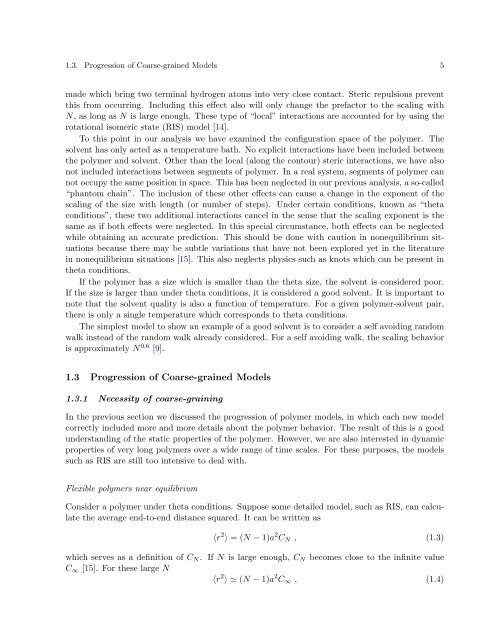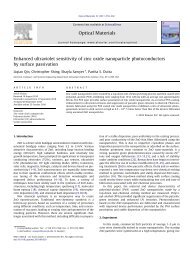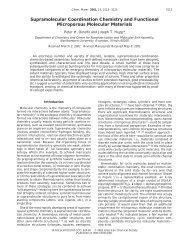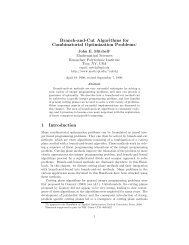Systematic development of coarse-grained polymer models Patrick ...
Systematic development of coarse-grained polymer models Patrick ...
Systematic development of coarse-grained polymer models Patrick ...
Create successful ePaper yourself
Turn your PDF publications into a flip-book with our unique Google optimized e-Paper software.
1.3. Progression <strong>of</strong> Coarse-<strong>grained</strong> Models 5<br />
made which bring two terminal hydrogen atoms into very close contact. Steric repulsions prevent<br />
this from occurring. Including this effect also will only change the prefactor to the scaling with<br />
N, as long as N is large enough. These type <strong>of</strong> “local” interactions are accounted for by using the<br />
rotational isomeric state (RIS) model [14].<br />
To this point in our analysis we have examined the configuration space <strong>of</strong> the <strong>polymer</strong>. The<br />
solvent has only acted as a temperature bath. No explicit interactions have been included between<br />
the <strong>polymer</strong> and solvent. Other than the local (along the contour) steric interactions, we have also<br />
not included interactions between segments <strong>of</strong> <strong>polymer</strong>. In a real system, segments <strong>of</strong> <strong>polymer</strong> can<br />
not occupy the same position in space. This has been neglected in our previous analysis, a so-called<br />
“phantom chain”. The inclusion <strong>of</strong> these other effects can cause a change in the exponent <strong>of</strong> the<br />
scaling <strong>of</strong> the size with length (or number <strong>of</strong> steps). Under certain conditions, known as “theta<br />
conditions”, these two additional interactions cancel in the sense that the scaling exponent is the<br />
same as if both effects were neglected. In this special circumstance, both effects can be neglected<br />
while obtaining an accurate prediction. This should be done with caution in nonequilibrium situations<br />
because there may be subtle variations that have not been explored yet in the literature<br />
in nonequilibrium situations [15]. This also neglects physics such as knots which can be present in<br />
theta conditions.<br />
If the <strong>polymer</strong> has a size which is smaller than the theta size, the solvent is considered poor.<br />
If the size is larger than under theta conditions, it is considered a good solvent. It is important to<br />
note that the solvent quality is also a function <strong>of</strong> temperature. For a given <strong>polymer</strong>-solvent pair,<br />
there is only a single temperature which corresponds to theta conditions.<br />
The simplest model to show an example <strong>of</strong> a good solvent is to consider a self avoiding random<br />
walk instead <strong>of</strong> the random walk already considered. For a self avoiding walk, the scaling behavior<br />
is approximately N 0.6 [9].<br />
1.3 Progression <strong>of</strong> Coarse-<strong>grained</strong> Models<br />
1.3.1 Necessity <strong>of</strong> <strong>coarse</strong>-graining<br />
In the previous section we discussed the progression <strong>of</strong> <strong>polymer</strong> <strong>models</strong>, in which each new model<br />
correctly included more and more details about the <strong>polymer</strong> behavior. The result <strong>of</strong> this is a good<br />
understanding <strong>of</strong> the static properties <strong>of</strong> the <strong>polymer</strong>. However, we are also interested in dynamic<br />
properties <strong>of</strong> very long <strong>polymer</strong>s over a wide range <strong>of</strong> time scales. For these purposes, the <strong>models</strong><br />
such as RIS are still too intensive to deal with.<br />
Flexible <strong>polymer</strong>s near equilibrium<br />
Consider a <strong>polymer</strong> under theta conditions. Suppose some detailed model, such as RIS, can calculate<br />
the average end-to-end distance squared. It can be written as<br />
〈r 2 〉 =(N − 1)a 2 CN , (1.3)<br />
which serves as a definition <strong>of</strong> CN. If N is large enough, CN becomes close to the infinite value<br />
C∞ [15]. For these large N<br />
〈r 2 〉(N − 1)a 2 C∞ , (1.4)







